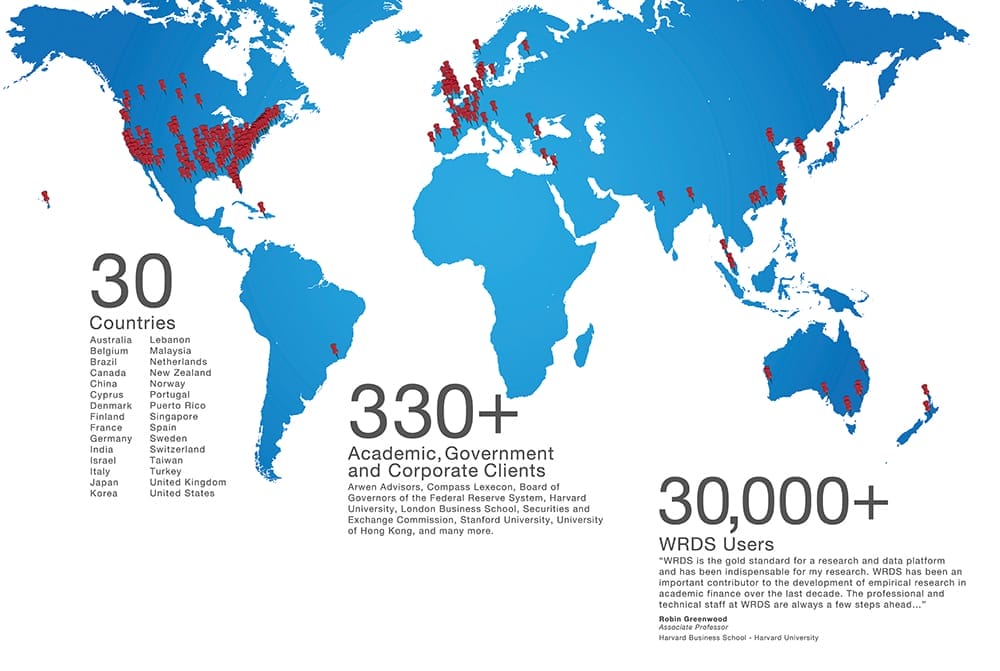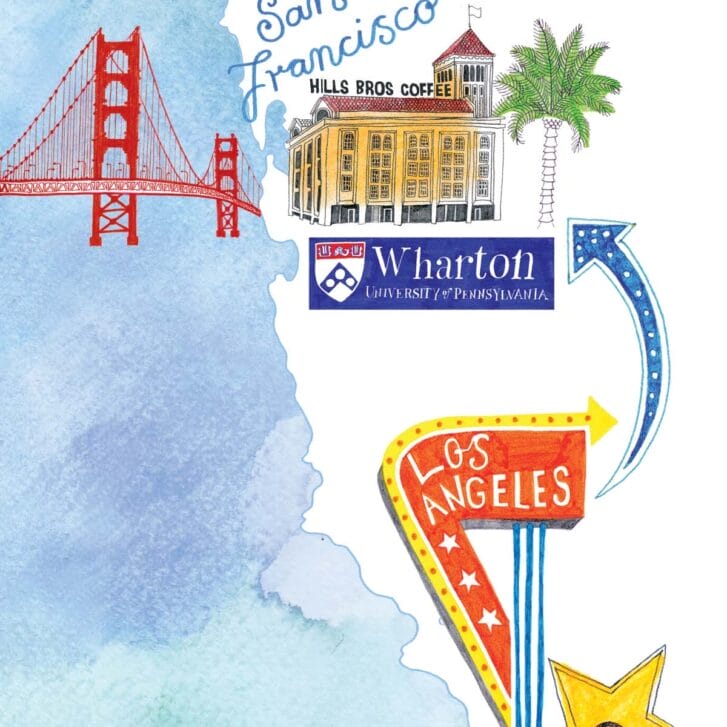Two years before Google founders Larry Page and Sergey Brin met, and four years before Lexis Nexis made its online debut, the Wharton School launched its own Web-based research and data application.
At a time when AOL was mailing its software to users on CDs, Wharton Research Data Services, or WRDS, was revolutionizing the way data was analyzed, accessed and distributed.
Demand for WRDS grew beyond Wharton—beginning with Stanford University in 1997. WRDS became an essential tool for any research institution working in finance, business or management, as well as a way for research institutions to recruit the brightest minds in the field, according to Paul Ratnaraj, the creator of WRDS and current director of sales and marketing. It enables researchers to model and analyze data more easily and in vastly faster time.
WRDS continues to build its repertoire of programs and services to support academia and, increasingly, the private sector. The organization plays a critical role in the School’s efforts to bridge the gap between academia and industry and to disseminate knowledge to the global business community.
“Now, as financial research and analysis gets more complicated, WRDS must continually improve its functionality to anticipate and meet the needs of financial researchers,” says Robert Zarazowski, senior director of WRDS.
“Our clients are some of the most prestigious institutions in global finance, and they demand both speed and accurate, reliable data,” he explains.
More Than a Data Platform
Wharton Research Data Services offers 200 terabytes of data to 30,000 users in 30 countries—including academic, government and corporate clients. It is one of the world’s leading Internetbased data research service, providing users with access to data from independent sources, such as Capital IQ, NYSE Euronext, Center for Research in Security Prices (CRSP) and Thomson Reuters.
Mark Keintz, G’77, a senior data analyst at WRDS, provides one example of the information WRDS offers: every trade and every quote from the New York Stock Exchange since 1993. And there is more data pouring in each day.
According to Keintz, WRDS receives nearly half of a terabyte of data—500,000 megabytes—every month.
This quantity of data requires the technical capacity to parse and sort relevant information. To improve user access and results, WRDS researchers validate data sets—comprised of historical records, macroeconomic time series, global marketing and industry reports—and provides essential tools including cross data set file linking, common queries and Ph.D.-level support.
Robin Greenwood, Ph.D., a professor at Harvard Business School, agrees that WRDS provides data in a unique structure, still unmet by other data services.
“It was really the only place in which one could get good stock return and financial data on U.S. companies … in a database form that was accessible to academic users,” says the decadelong WRDS user. “I don’t think anyone comes close in terms of the joint capability to access all these different types of data compared with WRDS.”
The financial industry is also taking note.
Doug Borden of Knight Capital Americas LLC says his organization reached out to WRDS for an analysis of equity trade data going back to 1993, which it now uses in its client presentations.
“Due to the complexity of the data and the … sheer quantity of computation required to process the data, [Knight Capital Americas] asked around in the industry to see if someone could help them process the [NYSE trade and quote] data … and either people were not capable of handling the size of the project or it would take them too long. … We were able to deliver the project in 10 days,” recalls Freda Song Drechsler, G’07, a WRDS researcher.
This is just the beginning. WRDS continues to create innovative products aimed at existing and first-time academic and corporate clients, such as investment banks, hedge funds, economic consultants and litigation support firms, according to Rabih Moussawi, Ph.D., a WRDS researcher.
As part of its service, WRDS provides more than the final answer to users. It places heavy emphasis on transparency, listing the algorithms and codes used to analyze data. WRDS’ open-source culture is unique, according to Moussawi.
“We provide the data as is, without any manipulation. We deliver add-on material that tells users if there are any biases or concerns relating to the data … and we provide routines and documentation that replicate peer-reviewed academic papers,” Moussawi says.
This add-on material allows users to run their own analyses and confirm findings, having very real and practical implications. And as the number of terabytes that WRDS hosts continues to climb, the organization has put an increasing emphasis on ensuring the users have the ability to perform their own research.
“We have become research enablers,” Keintz notes. “We have to be more than a data pipe.”
Leveraging the Penn Community
To do this, WRDS has leveraged resources that only the University of Pennsylvania can provide. After acquiring all SEC filings—totaling more than 12 million—WRDS partnered with the Department of Linguistics in Penn’s School of Arts and Sciences to apply linguistic and natural language processing insights to the parsing of the SEC filings.
This linguistic processing helps WRDS connect the SEC filings with data in multiple other databases, creating a more complete analysis. The project is so innovative that the SEC has become a WRDS client so it can access its own data in an easier-to- use format.
“Part of big data for us is not just understanding unstructured data, but it’s relating data from a wide variety of sources,” Keintz explains.
WRDS brings an element of Wharton’s academic rigor to the process.
“We like to analyze everything from a deep historical process. We try to discern the trends, going back 50 years ago,” explains Denys Glushkov, Ph.D., another researcher at WRDS.
This laborious approach stems from WRDS’s home at the Wharton School, as well as staff being researchers and academics. Holding advanced degrees, WRDS researchers teach and publish in finance and business and often have experience in the corporate world.
“It’s really impressive what they’ve done. You know, nobody had to do this, but it’s been a tremendous [asset]. They filled a huge gap,” praised Harvard’s Greenwood.


























